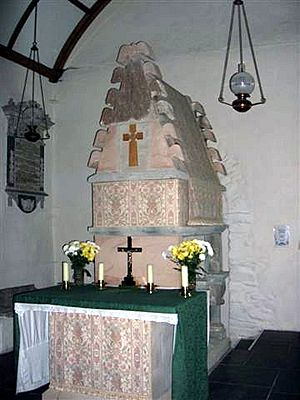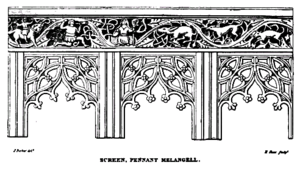Melangell facts for kids
Quick facts for kids Saint Melangell of Powys |
|
|---|---|

Shrine of St Melangell
|
|
| Abbess, Hermit | |
| Born | Ireland |
| Died | 590 Kingdom of Powys, Wales |
| Venerated in | Anglican Communion Catholic Church Eastern Orthodox Church Communion of Western Orthodox Churches |
| Major shrine | Saint Melangell's Church, Pennant Melangell |
| Feast | 27 May, and 5th Sunday of Pascha, the feast of the Samaritan Woman in the Orthodox Church. |
| Patronage | hares |
Saint Melangell (also known as Monacella) was an Irish nun who lived a long time ago, dying in the year 590. We celebrate her special day, called a feast day, on May 27. Melangell was the daughter of an Irish king. She decided to leave her home and travel to Powys in central Wales. There, she wanted to live a quiet life as a hermit, which means living alone and dedicating yourself to prayer.
One day, the prince of Powys, Brochwel Ysgithrog, met her during a hunting trip. He was so impressed by her that he gave her land. On this land, Melangell started a community for women. She became the abbess, or leader, of this community for 37 years. Today, her special place of worship, called a shrine, is still at St Melangell's Church, Pennant Melangell.
Contents
The Legend of Saint Melangell
The story of Saint Melangell is a famous Welsh legend. It was written down by a historian named Thomas Pennant (1726–1798).
Melangell's Escape
The legend says that Melangell was the daughter of an Irish king. Her father wanted her to marry a nobleman from his court. However, Melangell had promised to live a life dedicated to God and not marry. So, she ran away from her father's kingdom. She found a safe place in Wales, where she lived by herself for fifteen years. During this time, she didn't see any other people.
The Prince and the Hare
One day, Prince Brochwel Ysgithrog was hunting hares. He chased a hare until it ran into a thick bush. To his surprise, he found a beautiful young woman deep in prayer. The hare he was hunting was hiding under her clothes! The hunting dogs, usually fierce, stopped and howled from a distance. They wouldn't go near her, even when the hunters tried to make them. The huntsman even tried to blow his horn, but it got stuck to his lips!
A Place of Safety
Prince Brochwel heard Melangell's story. He was so amazed by what he saw that he decided to give her a piece of land. This land would be a sanctuary, a safe place for anyone who needed protection. He asked her to build a religious community there. Melangell did as he asked and became the abbess of the community. She lived a long life and was buried in the nearby church, which was later named Pennant Melangell after her.
Melangell and the Hares
People say that Melangell's hard bed was a cleft in a nearby rock. Her tomb was in a small chapel next to the church, which is now used as a storage room. This room is still called 'Cell-y-bedd', meaning 'Cell of the Grave'. Over time, her holy items and a statue of her were moved. However, some old wooden carvings show Saint Melangell with many hares running to her for safety. Because of this story, she became known as the special protector of hares. People even called the hares 'Oen Melangell', which means 'St. Monacella's Lambs'.
Honoring Saint Melangell
Saint Melangell is honored in different Christian traditions. Her feast day, a special day to remember her, is on May 27 in the Western Church. In the Eastern Church, it's celebrated on the 5th Sunday after Pascha (Easter).
Her Shrine at Pennant Melangell
Prince Brochwel Ysgithrog gave the valley near Saint Melangell's Church, Pennant Melangell to Melangell. This became a safe place, and she became the abbess of a small religious group there. After she died, people continued to honor her at her shrine. For many centuries, Pennant Melangell has been a place where people go on pilgrimage, a special journey for religious reasons. Melangell is still known as the patron saint of hares. Some bones, believed to be hers, are kept within the shrine.




